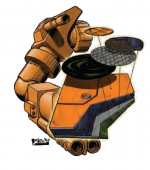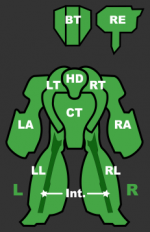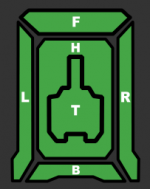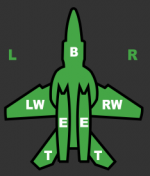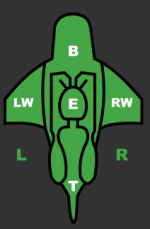Armor
NOTE: "Armor" can also mean a tank, hovercraft, or mobile artillery that has yet to be specifically identified by one's radar.
Overview
Armor is the 'health' or 'hitpoints' of each asset, besides BA. When an asset is damaged, armor is destroyed or blown off of whatever section, or hitbox was hit by the weapon. Each asset has a different amount of armor on each of its different parts. Each part, or 'component', has it's own value that is tracked separately from each other. Each component can be singled out for damage by aiming at specific hitboxes that are visible on the asset. For example, by aiming and shooting at the turret of a tank, the tank's turret armor can be damaged. By reducing the armor of a single component to zero, it is usually destroyed. There are typically other consequences associated with this like destroyed weapons, reduced maneuverability, or death. Some hitboxes are large, like the side torsos on a [[[Mauler]]], while other hitboxes are small, like the turret on a Shoden. Hitbox size and location, and whether or not the pilot can quickly move that component out of line of sight, affects how easy it is to damage that particular component.
Armor can be repaired at a Repair Pad or in some Mech Hangars at the cost of CBills.
See Stats for asset armor values.
Mech
Excepting the legs, when the armor of a 'Mech component reaches zero, that component is destroyed. Legs function slightly differently; they have internal structure values tied to them. As this structure is damaged, the 'Mech will suffer heavily reduced mobility and turning rates. Once the internal structure of a leg reaches zero the leg is effectively destroyed, causing the 'Mech to fall over. Due to the way 'Mechs are implemented in MWLL and the limitations of CryEngine, once one leg is destroyed, the other can no longer be hit.
All mechs in MWLL have a head, center torso, left torso, right torso, back torso, left arm, right arm, left leg, and a right leg. Some mechs also have externals. Externals are treated more or less like extra arms on the mech, but only aim along with other torso mounted weapons. Externals don't gain the benefit of being able to shoot at wider angles like mech arms.
Some 'Mechs like the Solitaire, Chimera and Hollander II have asymmetrical armor distribution to protect their main weapon(s) or easier-to-hit side torso. This extra protection does not come for free: their other side torso is always less armored and can be destroyed more easily.
Shooting a destroyed side torso will cause the damage to transfer to the center torso. The amount of damage transferred depends on what engine the 'Mech has; Inner Sphere XLs suffer double damage, Clan XLs take 66% more, Inner Sphere Light Fusion engines receive 50% more, while 'Mechs with Standard (Std.) engines like the Atlas do not suffer any multiplier. Regardless of chassis asymmetry, or mounting... Whether Inner Sphere XL, Clan XL, or Std. Engine.... Shooting through a all of a side torso's armor and spreading into the Center Torso will always take longer to destroy the the Mech than shooting the Center Torso itself, barring the clever utilization of splash damage weapons. While they're a slower route, side torsos can be harder to defend by twisting, and often hold vital weaponry that will become disabled on destruction.
If the rear torso is heavily damaged or destroyed, damage transfers to the center torso with a x3 multiplier and the 'Mech loses half its maximum speed as well as some heat dissipation. This reflects the engine damage that can be dealt and also makes shooting the backs of 'Mechs much more effective.
Destroying a 'Mech's arm or external will permanently destroy that component, unlike a destroyed head, back torso, or side torsos which can be repaired. Arming or externaling a 'Mech can be a good strategy against larger 'Mechs. Sometimes it isn't possible to win in combat against a larger opponent, but causing permanent damage by removing arms or externals can be an effective strategy to make the enemy permanently weaker, often forcing the enemy to sell their 'Mech.
Vehicles
Not to be confused with base defenses, the turret for every almost every vehicle is a heavily armored component and is typically the location where most or all of the vehicle's weapons are mounted. The Front panel will typically have the most armor of the panels, followed by either Left or Right panels having moderate armor, and the Back panel having the least armor. While it is quicker to focus fire on a weaker side or back panel, competent tank and hover pilots will rotate their chassis to hide their damaged panels as they wear out. While the turret is the most armored component, no amount of rotating can hide its visibility.
When a vehicle loses a side, it will suffer loss of mobility or turn rate, depending on which area is lost. If the turret is destroyed, its traverse rate is severely degraded but the vehicle will not lose any weapons.
Any damage dealt to a destroyed area on a vehicle transfers damage to its internal structure. If internal structure reaches zero, the vehicle is destroyed.
Hovercraft have most of their armor reinforcing their front panel, giving them some extra protection when peeking above terrain- however, this leaves their turrets only slightly more armored than either side panel.
Tanks and wheeled vehicles have most of their armor reinforcing their turret, having only slightly less armor than both of the side panels combined, making it extra important for tank drivers to keep their less-armored panels out of harms way.
The only exception to this is the Chevalier, a wheeled light tank that is unable to rotate in place. Both its left and right panels have the most armor, followed second by its front panel, turret- and rear. This makes the vehicle durable in strafing runs against the enemy, but also makes it vulnerable against pilots with a steady hand to focus its lightly armored turret.
Aerospace Fighters
Aerospace fighter (ASF) damage functions similarly to that of vehicles, except aerospace fighters have no internal structure; as soon as their Body hits zero, they are destroyed.
Losing a wing causes weapon loss and a slight maneuverability reduction -- the ASF is still airworthy with a destroyed wing, although it becomes much more vulnerable to being killed, as shots to a destroyed wing transfers damage to the body at a 3.0x rate, making it a viable tactic for defeating ASFs provided you can consistently hit the same wing. Like losing the arm of a mech, repairs will not restore a lost wing- making it a dangerous gamble to invest in reusing a wingless plane, instead of selling it.
Tail loss severely mitigates the ASF's ability to fly and strafe properly by limiting its ability to pitch up and down. Engine loss cuts the overall engine power of the ASF in half, which is highly detrimental to the ASF's combat performance.
If both the tail and engine are destroyed, the ASF is no longer airworthy, it will lose much of its top speed, won't be able to boost, and will be incapable of taking off again after landing.
VTOLs
VTOL damage is analogous to that of ASFs, except in that tail or engine loss is typically fatal due to the effects losing either section has on the VTOL. Without either component, the VTOL's maneuverability or speed becomes so low that it is effectively a sitting duck.
Canon
Ferro-Fibrous armor (FF) is a special type of armor used by vehicles and BattleMechs. Utilizing a weave of ferro-steel, ferro-titanium, and diamond weave fibers which boosts the tensile strength of the plating, it provides more protection per ton than standard armor (12% for Inner Sphere FF, 20% for Clan FF), but takes up more space on the 'Mech or vehicle (14 critical slots for Inner Sphere, 7 for Clan 'Mechs; two slots for Inner Sphere vehicles, one for Clan). The maximum amount of protection is not changed; merely the weight of armor required to achieve that level of protection. For a unit which already has maximum armor protection, it is therefore considered a weight-saving measure, at the cost of critical space. The weight savings for Endo Steel are greater than those saved by ferro-fibrous armor, but it is more costly and obviously more difficult to repair or add as an upgrade to a 'Mech. First developed by the Terran Hegemony in 2571, Ferro-Fibrous armor was lost to the Inner Sphere during the Succession Wars. The Draconis Combine was the first to re-create it in 3040. Later, the Free Worlds League and Lyran Alliance would develop Light and Heavy versions of Ferro-Fibrous armor.
| ||||||||||
